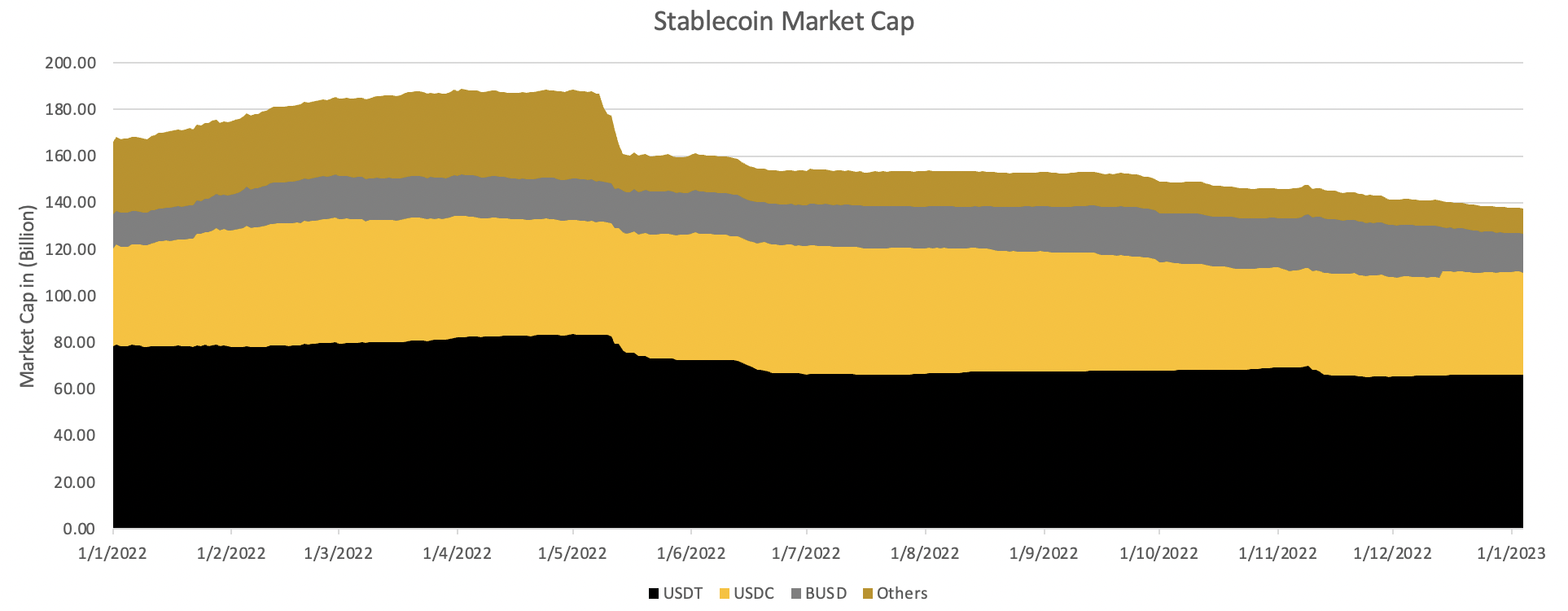Declining Demand for Binance’s BUSD Represents New Chapter in Stablecoin Wars

Binance, the world’s largest crypto exchange, made a big push last year to promote its own stablecoin, BUSD, over those of rivals.
But recent speculation over the exchange’s health appear to have undermined the progress, following a spate of $5.5 billion of net redemptions from BUSD in a month. The decline in demand for the stablecoin coincided with other data in December showing outflows of cryptocurrency deposits on the exchange.
The market capitalization of BUSD – the number of stablecoins outstanding times its price, theoretically $1 – fell to an 11-month low of $16.4 billion on Jan. 3 from $22.1 billion at the start of December, according to data by CoinGecko. BUSD remained the third largest stablecoin by market capitalization.
BUSD is issued by the New York-based financial technology firm Paxos Trust Company under the Binance brand, anchored to the $1 price primarily by assurances that it’s backed by cash and U.S. Treasury bills in reserves. Like rival stablecoins including Tether’s USDT and Circle’s USDC, its purpose is to convert traditional fiat money to crypto assets and facilitate trading.
When BUSD or stablecoin holders redeem their tokens, the number of tokens in circulation decreases while the price ostensibly stays anchored to the peg.
The recent decline in the amount of BUSD outstanding wiped out the gains that came after Binance’s move in September to ditch several rival stablecoins and automatically convert deposits into BUSD; Binance officials described the move as an attempt to consolidate trading pairs on its exchange platform. The move was seen by some crypto analysts and industry observers as promoting BUSD as a challenger to USDT and USDC, the two largest stablecoins by market value.
The effort helped push the BUSD market capitalization as high as $23 billion in November, from $18 billion in August before the auto-conversion went into effect.
But then, last month, Binance endured a wave of user withdrawals after a widely criticized report on its crypto reserves by auditing firm Mazars rocked confidence in the exchange’s stability – especially since the industry was still on tenterhooks following the rapid collapse of FTX in November. Subsequently, Mazars paused all work with crypto clients and deleted Binance’s proof-of-reserves assessment from its website.
“Binance’s auto-conversion was a double-edged sword,” according to Tom Wan, research analyst at digital asset investment-product firm 21.co.
As Binance users withdrew stablecoins from the exchange, they did that in the form of USDC and USDT, so Binance had to redeem BUSD to Paxos and prop up reserves of rival stablecoins to satisfy withdrawals, Wan explained.

Conor Ryder, an analyst with the digital asset research firm Kaiko, wrote in a report this week that growing adoption of stablecoins in developing countries prone to currency depreciation could be “crypto’s killer use case.”
“Stablecoins look to be crypto’s best example of product market fit and they’re genuinely improving a vast amount of lives in these countries,” he wrote.
While the once-$3 trillion cryptocurrency market’s overall value has plummeted to $840 billion, the stablecoin market held up relatively well, contracting to $138 billion from a $188 billion high in 2022 – suggesting that fiat-pegged stablecoins are seen as a haven for many crypto traders during a bear market.
Learn more about Consensus 2023, CoinDesk’s longest-running and most influential event that brings together all sides of crypto, blockchain and Web3. Head to consensus.coindesk.com to register and buy your pass now.






 Bitcoin
Bitcoin  Ethereum
Ethereum  Tether
Tether  USDC
USDC  Dogecoin
Dogecoin  Cardano
Cardano  TRON
TRON  Chainlink
Chainlink  Stellar
Stellar  LEO Token
LEO Token  Hedera
Hedera  Bitcoin Cash
Bitcoin Cash  Litecoin
Litecoin  Monero
Monero  Dai
Dai  OKB
OKB  Gate
Gate  Ethereum Classic
Ethereum Classic  Cronos
Cronos  VeChain
VeChain  Cosmos Hub
Cosmos Hub  Algorand
Algorand  KuCoin
KuCoin  Maker
Maker  Stacks
Stacks  Tether Gold
Tether Gold  IOTA
IOTA  Theta Network
Theta Network  Tezos
Tezos  Zcash
Zcash  TrueUSD
TrueUSD  NEO
NEO  Polygon
Polygon  Dash
Dash  Zilliqa
Zilliqa  Synthetix Network
Synthetix Network  0x Protocol
0x Protocol  Qtum
Qtum  Basic Attention
Basic Attention  Decred
Decred  Siacoin
Siacoin  Holo
Holo  Ravencoin
Ravencoin  NEM
NEM  DigiByte
DigiByte  Enjin Coin
Enjin Coin  Ontology
Ontology  Nano
Nano  Hive
Hive  Waves
Waves  Lisk
Lisk  Status
Status  Steem
Steem  Numeraire
Numeraire  Pax Dollar
Pax Dollar  BUSD
BUSD  Huobi
Huobi  OMG Network
OMG Network  Bitcoin Gold
Bitcoin Gold  Ren
Ren  Bitcoin Diamond
Bitcoin Diamond  HUSD
HUSD  Bytom
Bytom